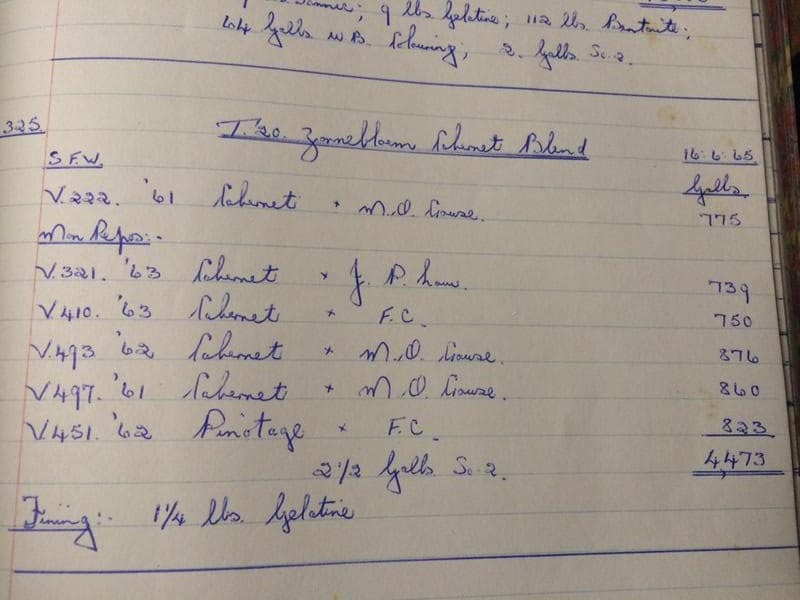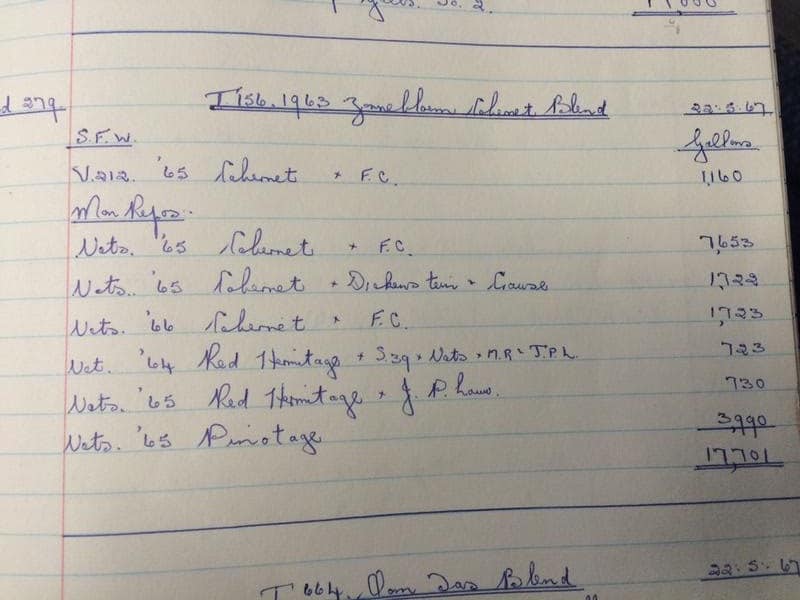What went into the Zonnebloem Cabernet 1965?
By Christian Eedes, 8 May 2015

5
One of the highlights of the recent South African Old Wine Tasting to mark the beginning of judging at the Old Mutual Trophy Wine Show was the Zonnebloem Cabernet 1965 (see here).
By all accounts, a lot of leeway was allowed when it came to compiling these wines and asked Elize Coetzee, part of the current Zonnebloem winemaking team, to check the records as to what actually went into this wine and here’s what she came back with:
 Firstly there was a blend put together on 16 June 1965 with no indication of what vintage it was bottled as which consisted of: 34% Cabernet 1961, 31% Cabernet 1963, 18% Cabernet 1962 and 17% Pinotage 1962.
Firstly there was a blend put together on 16 June 1965 with no indication of what vintage it was bottled as which consisted of: 34% Cabernet 1961, 31% Cabernet 1963, 18% Cabernet 1962 and 17% Pinotage 1962.
 Then there was a blend put together on 22 May 1967 and evidently labelled “1963” which included 59.5% Cabernet 1965, 10% Cabernet 1966, 22.5% Pinotage 1965, 4% Cinsaut 1964 and 4% Cinsaut 1965.
Then there was a blend put together on 22 May 1967 and evidently labelled “1963” which included 59.5% Cabernet 1965, 10% Cabernet 1966, 22.5% Pinotage 1965, 4% Cinsaut 1964 and 4% Cinsaut 1965.
The two fascinating insights from the above are 1) these wines were technically “Non-Vintage” and 2) the use of Cinsaut and Pinotage which evidently have not detracted whatsoever from the age-worthiness of these wines.







Dana Buys | 10 May 2015
Very interesting to see the old records! I wonder if the F.C. was Furter Crouse per Tim’s article? Seems like quite a high % of these component wines could still have come from Zonneblom in the early 60’s.
Tim James | 8 May 2015
PS. In fact, looking at your photos of the records again, it seems to indicate the origins of the different parcels of wine that went into the blend.
Tim James | 8 May 2015
That is really fascinating info about the blends, and thanks for getting it. It’s worth remembering that by this time there had long been no connection apart from the name between the Zonnebloem made by Stellenbosch Farmers Winery and the famous Zonnebloems of the 40s and 50s, which came from one property of that name, and was probably much more straight Cabernet, with some Cinsaut. SFW allegedly appropriated the well established brand name in a pretty underhand way and by 1963 Zonnebloem’s grapes were not even going to SFW but to Drakenstein Coop. It’s a fascinating story, that I covered briefly on Grape, in an article (http://wp.me/p3DdtR-3e) which includes a link to a much longer bit of historical research by a Stellenbosch academic, if nanyone wants to follow it up.
Christian Eedes | 8 May 2015
Hi Guy, I guess what I meant to say was the “overall greatness” of the wine. You are entirely correct that (some) Pinotage ages extremely well – I’ve been lucky enough to taste Lanzerac from the 1960s quite often and those wines are usually pretty special. What I think we should hang on to here is that while Cabernet’s credentials as a noble variety are not in question, Pinotage (and Cinsaut) aren’t normally considered in the same league but certainly did not compromise the Zonnebloems of four or five decades ago…
Guy | 8 May 2015
Why would you think that Pinotage would “detract from the age-worthiness” of the wines – possibly even adds to it?